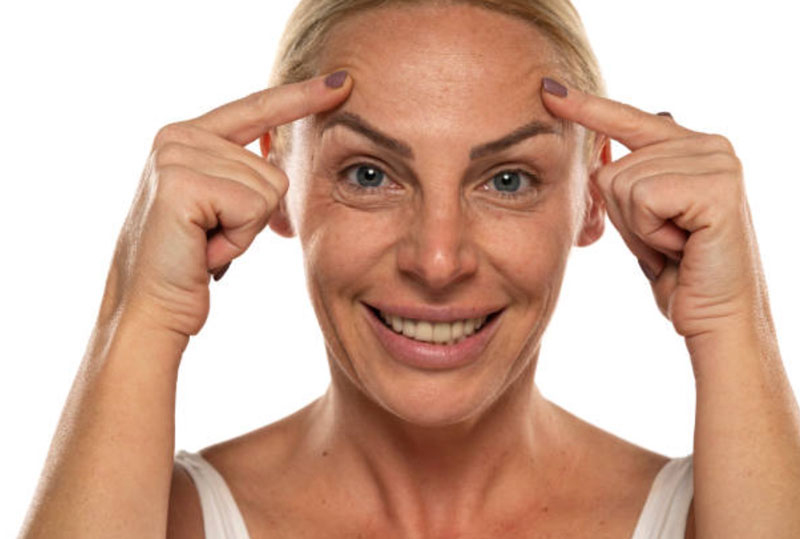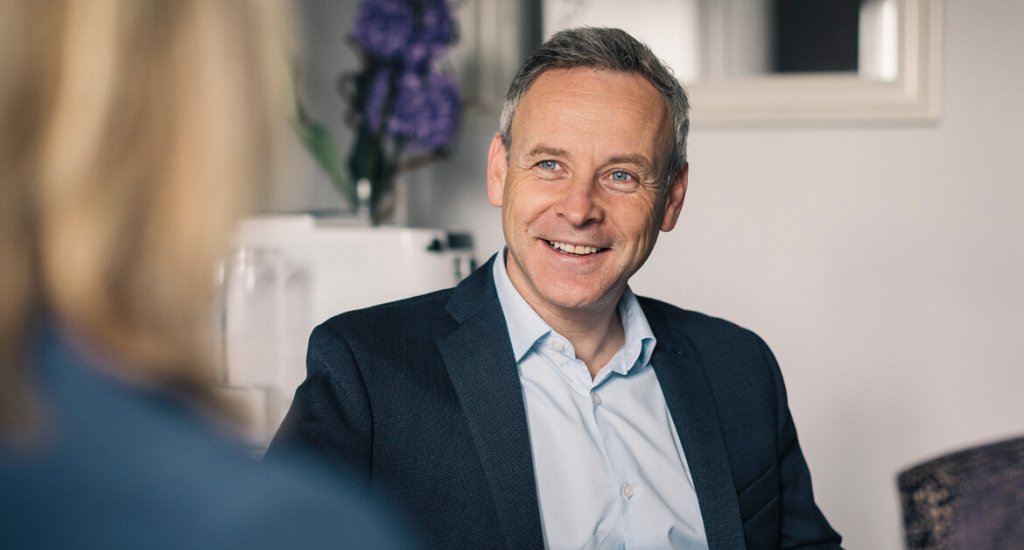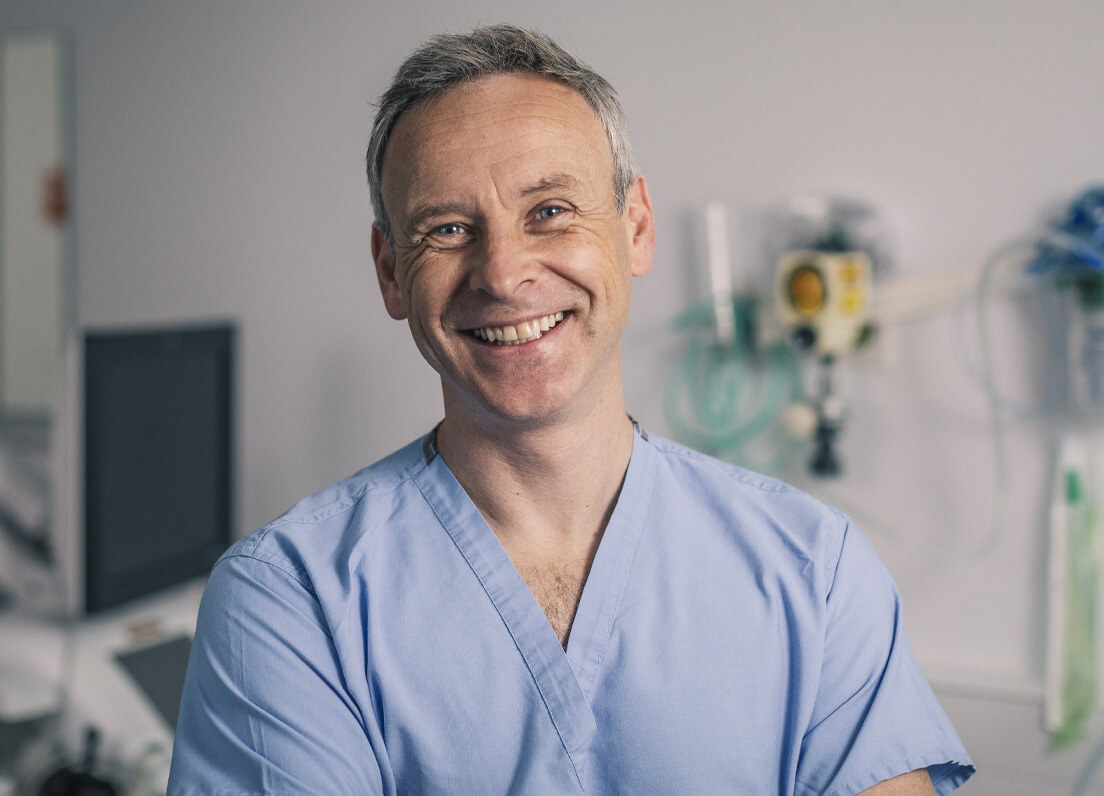Facial rejuvenation surgery, specifically facelift and neck lift procedures, have become popular options for those seeking to reverse the signs and effects of ageing. Over time, the natural ageing process can cause the skin on the face and neck to sag, leading to a tired or aged appearance. Fortunately, facelift and neck lift surgeries are effective solutions that can significantly improve your overall facial appearance.
In this blog, Bristol-based Consultant Plastic Surgeon Anthony MacQuillan explains the details of the facelift and neck lift procedures and how they can be used to address visible signs of ageing.
Five Visible Signs of Ageing on the Face
Understanding the manifestations of ageing on the face is essential before considering rejuvenation procedures such as facelift and neck lift. These ageing signs, often varying in severity and occurrence from individual to individual, affect one’s aesthetic appearance. Here are some of the signs of ageing:
1. Wrinkles and Fine Lines
One of the most noticeable signs of ageing is the development of wrinkles and fine lines. These are primarily due to the loss of skin elasticity and breakdown of collagen – a structural protein essential for skin strength and elasticity. As we mature, natural oil production decreases, skin becomes drier, and lines form more easily. Particularly, the forehead may harbour deep lines due to habitual facial expressions, the eye periphery might exhibit ‘crow’s feet’ from years of expressive smiling or frowning, and laugh lines or nasolabial folds become more pronounced around the mouth. These changes contribute to an overall aged appearance. Wrinkles and fine lines are not the primary target in a face life – the aim from the procedure is to reposition the underlying anatomy (and address volume loss). The aim is not to stretch the skin so tightly it no longer has wrinkles – in addition to distorting the facial features this also result in the skin dying (skin necrosis) as the tension would prevent blood flow within it (think of how your knuckles blanche when you make a fist). To address the wrinkles within the skin itself other modalities such as laser resurfacing, microneedling or skin peels are needed. These treatments will need to be repeated regularly in order to achieve optimal results and should be considered an essential addition to optimising your outcome following surgery
2. Sagging Skin
Over time, the relentless pull of gravity, coupled with the diminution of collagen and elastin fibres, results in sagging skin. This sagging is most noticeable in certain areas of the face: the cheeks tend to lose their youthful plumpness and begin to droop, the jowls become more pronounced as the jawline softens, and the neck may develop loose, hanging skin often termed a ‘turkey neck’. The loss of firmness alters facial contours, significantly affecting one’s youthful visage. Skin sag is not just loss of tone within the skin however, the underlying facial skeleton also shrinks so the structure on which the skin sits alters leaving ‘excess’ as a result of loss of skeletal projection – this is compounded by reduction in the amount of soft tissue ‘padding’ to the face (essentially reduction in substance of the deep fat pads located particularly in the mid face region). In short some of the skin sag is the result of …. volume loss!
3. Volume Loss
Ageing isn’t just about the changes on the skin’s surface; it’s also about the losses beneath. Subcutaneous fat, which gives faces a youthful, rounded appearance, diminishes over the years. This reduction causes hollows to appear, most notably in the under-eye area, cheeks, and temples, leading to a gaunt, aged look. Bone resorption also occurs with ageing, further contributing to changes in the facial structure and contours
4. Uneven Skin Tone and Texture
The cumulative effect of sun exposure, known as photoageing, alongside the natural ageing process, can lead to significant changes in skin tone and texture. The skin’s surface might become coarse and develop a rough, leathery texture. Age spots, resulting from sun exposure, and generally uneven skin tone, perhaps from melanin distribution changes, contribute to a worn appearance. Additionally, the slow shedding of skin cells and reduced natural oil production may give the skin a dull, lacklustre look rather than a youthful glow
5. Visible Facial Veins and Pigmentation
As the skin thins with age, blood vessels under the skin can become more prominent, leading to the appearance of facial veins, especially around the nose and cheeks. Furthermore, pigmentation irregularities, such as hyperpigmentation or hypopigmentation, are common, resulting from a combination of sun damage, hormonal influences, and the ageing process itself. These vascular and pigmentation changes add to the unevenness of skin colour, detracting from its youthful uniformity
What can be done about the effects of ageing?
Modern facial rejuvenation procedures, such as deep plane facelifts and deep neck lifts, address these issues more holistically.
By addressing anatomical changes and returning the underlying tissues to their correct position, restoring lost volume, and improving overall skin tone and texture (achieved through adjunctive treatments such as laser skin resurfacing), these surgeries offer solutions that contribute to restoring a youthful, revitalised appearance, with long-lasting outcomes.
Consider Facelift Surgery
A facelift, also known as a rhytidectomy, is a surgical procedure that rejuvenates the face by targeting specific signs of ageing. It involves lifting and tightening the underlying muscles and tissues, as well as removing and re-draping excess skin.
Facelift surgery can address multiple concerns, including:
- Sagging skin on the cheeks and midface
- Deep creases between the nose and mouth (nasolabial folds)
- Folds between the cheek and lower lip (marionette lines)
- Loss of definition along the jawline (jowls)
- Fat deposits and tissue laxity in the lower face and neck
- Excess skin and wrinkles on the lower face and neck
During a facelift procedure, incisions are typically made around the hairline and extend from the temples to the lower scalp. Anthony carefully lifts and repositions the underlying tissues, removes or redistributes fat deposits, and trims away any excess skin. The result is a smoother, firmer, and more youthful facial appearance.
It’s important to note that a facelift does not address all signs of facial ageing or improve the quality of the skin itself. To achieve comprehensive facial rejuvenation, additional procedures such as a neck lift or non-surgical treatments may be recommended, depending on the individual’s specific needs and goals.
Consider just a Neck Lift Procedure?
One of the areas most affected by ageing is the neck. A neck lift procedure, also known as cervicoplasty, aims to tighten and enhance the neck’s appearance by reducing sagging skin, fat deposits, and muscle banding.
During a neck lift, incisions are made behind the ears and possibly under the chin to access the underlying tissues. Anthony will then tighten the muscles, remove excess fat, and reposition or remove any excess skin. This approach brings about a more contoured and youthful neck profile.
A neck lift can effectively address various concerns, including:
- Double chin or excess fat beneath the chin
- Vertical neck bands caused by muscle laxity
- Sagging jowls and loose neck skin
- Visible horizontal lines, commonly referred to as “necklace lines”
By focusing on the neck area, a neck lift complements the results achieved through a facelift and helps create a harmonious and balanced facial rejuvenation outcome.
Combining a Facelift and Neck Lift
Facelift and neck lift procedures are ideal options for individuals interested in reversing the signs of ageing and achieving a more youthful facial appearance. These procedures can effectively address concerns such as sagging skin, wrinkles, volume loss, neck bands, and more.
There are many types of facial rejuvenation surgery available. Consulting with a qualified and experienced plastic surgeon is vital to determine the most suitable treatment plan tailored to one’s unique needs and desired outcomes. With advancements in surgical techniques, facial rejuvenation surgeries continue to provide impressive results.

FAQs about Facelift, Neck Lift and the Signs & Effects of Ageing
What are the signs and effects of ageing that can be addressed by a facelift and neck lift?
- The signs of ageing most commonly addressed by these procedures include sagging skin, deepening of the nasolabial folds and marionette lines, fat displacement or volume loss, jowls, loose skin and platysmal banding in the neck. These problems usually result from a combination of age, genetics, environmental factors, and personal habits, contributing to an older appearance.
At what age should I consider a facelift or neck lift?
- There’s no specific “right” age for these procedures, as individual genetics and lifestyles significantly influence skin ageing. Most patients who choose facelifts or neck lifts are between the ages of 40 and 70. However, the key is to consider such surgery when non-invasive treatments are no longer giving you the results you want, but your skin still has some elasticity to facilitate healing and contouring.
Are the results from a facelift and neck lift permanent?
- While a facelift and neck lift can turn back the hands of the clock, they don’t stop the ageing process. Your skin will continue to age, and factors like genetics, sun exposure, and nutrition will affect the longevity of your results. You’ll likely still look younger years later than you would have without the surgery.
What is the difference between a facelift and a neck lift?
- A facelift primarily addresses sagging, excess skin, and deep facial creases, particularly around the nose and mouth, as well as jowls and marionette lines. A neck lift focuses on the area below the chin, correcting issues like a “turkey neck,” fat accumulation, or abnormal contours due to muscle banding. These procedures can be done separately or together, depending on individual needs.
How long is the recovery time for these surgical procedures?
- Recovery can vary significantly depending on the individual and the extent of the surgery. Generally, most swelling and bruising resolve within 2 to 3 weeks post-surgery. A complete return to normal activities, including exercise, might take 4 to 6 weeks. It’s essential to follow Anthony’s post-operative instructions to ensure a smooth recovery.
Are there non-surgical alternatives to facelifts and neck lifts?
- There are non-invasive treatments like dermal fillers, botulinum toxin, and laser treatments that can provide temporary results by reducing the appearance of lines and wrinkles, restoring lost volume, and stimulating collagen production. These treatments might be suitable for individuals who are not ready for surgery or those with less pronounced signs of ageing.
What are the risks associated with facelift and neck lift procedures?
- As with any surgery, there are risks involved. These can include complications related to anaesthesia, infection, bleeding, scarring, nerve injury with potential weakness, asymmetry, and dissatisfaction with aesthetic results. Anthony will spend time discussing and explaining all of the relevant risks that you need to know about during your consultation as well as providing you with a comprehensive consultation letter covering all of the topics discussed at your consultation. Anthony believes that it is very important that you understand the technical aspects of the surgery, the related anatomy and the risks and complications associated with the procedure so that you are equipped with all the knowledge you need to allow you to make the right decision for you.
Further Reading about Face Surgery with Consultant Plastic Surgeon Anthony MacQuillan
- Read more about Eyelid Surgery
- Read more about Facelift Surgery
- Read more about Ear Correction Surgery
- Read more about Ful Facelift vs Mini Facelift
- Read more about What is a Mini Facelift
- Read more about Recovery after Blepharoplasty
Medical References about Facelift and Neck Lift Surgery
- Facelift (Rhytidectomy) – Cleveland Clinic
- Facelift Procedure Steps – ASPS
- Facelift (Rhytidectomy) – NHS
- Facelift Surgery Guide – ABCS



